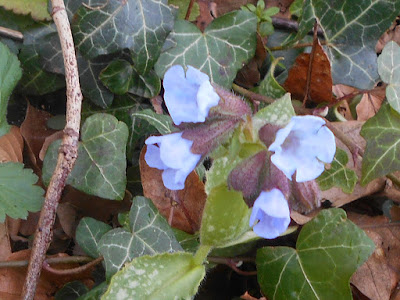Today, in Byfield, I found several specimens in flower but conditions were too chilly and dull for any insect visitors to be present.
A plant with bright blue flowers, growing in a friend's garden, was almost certainly the very popular 'Blue Ensign' (but see Footnote).
 |
Pulmonaria officinalis, perhaps the form known as Blue Ensign
Garden in Byfield, Northants, 18 March, 2020
|
Growing in a hedgerow on the edge of the village was Pulmonaria officinalis, perhaps of the variety known as 'Rubra'.
 |
Pulmonaria officinalis rubra, growing in a hedgerow. Byfield
Northants, 18 March, 2020
|
Yet a third, pale blue example, was growing on a shady bank, unsuppressed by the rampant ivy around.
 |
A pale blue form on a shady bank, Byfield, Northants.
18 March, 2020
|
There are around a dozen species of Pulmonaria, give or take, found wild in Europe though to Central Asia but all the plants seen today, despite the variation on colour, were specimens of the Common Lungwort, Pulmonaria officinalis. The species has many common names such as Jerusalem Cowslip, Mary's Tears or Spotted Dog. The last of these names, and the second one too, refers to the pale spots on the leaves, clearly visible in the first and third pictures.
The spots were once regarded, in accordance with 'the doctrine of signatures' as an indication of how the plant should be used medicinally. As these spots appeared to resemble diseased lungs they were employed accordingly. Another descriptive old name is Mary-spilt -the-milk and also refers to the white blotches.
Many species open pink and gradually turn blue as they develop so it is often best to see a plant in full flower before purchasing plants.
Incidentally a species of lichen, Lobaria pulmonaria, is also known as lungwort, and was used by herbalists in a similar manner.
It does not occur in Northamptonshire but perhaps vaguely resembles ravaged lung tissue.
Footnote I have since been advised by a fellow-blogger that 'Blue Ensign' has unspotted leaves. Thanks Stasher.
Footnote I have since been advised by a fellow-blogger that 'Blue Ensign' has unspotted leaves. Thanks Stasher.

I used to have Pulmonaria Blue Ensign in my previous garden, but this one must be another type as BE does not have spots on its leaves. Now I have just one Pulmonaria: Sissinghurst White, and it has had a very large bumblebee visiting it over the last few days. We have had bees working the rosemary which has been in flower all winter.
ReplyDelete